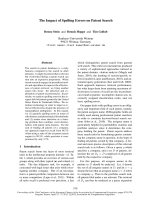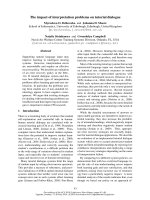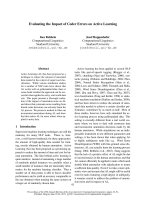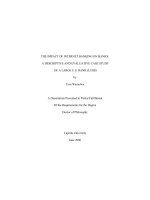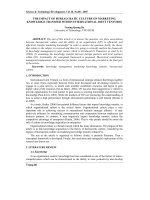2023 the impact of digital disruption on the publishing industry (1)
Bạn đang xem bản rút gọn của tài liệu. Xem và tải ngay bản đầy đủ của tài liệu tại đây (97.24 KB, 7 trang )
TOPIC: THE IMPACT OF DIGITAL DISRUPTION ON THE
PUBLISHING INDUSTRY
In the context of the fourth industrial revolution with scientific and high-tech application
models, the appearance of many modern media and the diversity and information explosion
have profound impacts on all faces of social life (Daidj, 2015). New trends in the field of
journalism and publishing, such as direct interaction and personalization of information, are
drastically changing the way organizations produce information (Gaigher, et al., 2014). The
rapid development of storage technology, audio transmission, image and multimedia
communication models allows the creation of many high-quality journalism products, from
long, high-volume genre articles to in-depth analytics, from virtual reality products to
artificial intelligence (AI) messaging applications to interact with readers (Ness, 2018).
Competition of press forms, traditional publishing with modern types, such as social
networks, e-books (electronic books), virtual reality augmented books (vr-books), e-book
applications on Smartphones ... led to the fact that print newspapers face a decline in revenue,
electronic newspapers have to compete with social networks, publishing activities face many
difficulties (Jiang & Katsamakas, 2010). This paper aimed to explore and identify the
impact of digital transformation on the publishing industry in terms of consumer books.
Under the influence of the fourth industrial revolution, e-publishing has created utilities that
outweighed traditional publishing, which changed the publishing model and process as well
as reading habits and culture of consumers (Bashorun, et al., 2013). In this context, along
with existing models, there will be new models in which the focus of the publishers is not
only on the product itself, but on customer-oriented processes. Publishers move from the role
of the producer who create the publishing product to the role of service provider who provide
content and information to connect the reader with the author (Oppenheim, 2008). Research
and studies have predicted that there will be three parallel publishing models that possibly
exist: Traditional model, focusing on printing (for big brands); model between media
concentrating on creating and distributing content on different channels (for corporations
holding big data and distribution networks); model of creating content services based on
digital platform and customer network (model of the future - model 4.0) (Bashorun, et al.,
2013).
Along with the shift of the existing publishing model, there is also the appearance of a
completely new publishing process - direct publishing by individuals (Jiang & Katsamakas,
2010). With electronic format, through the companies that hold bigdata infrastructure, the
author brings his own books which are considered "brainchild" directly to readers without
editing, introducing and advertising provided by the publishers as traditional publishing
model (Warren, 2010). This means that the center of the publishing process no longer belongs
to the publisher but the media holding the bigdata infrastructure. It is obvious that if the
author is not well-known or the book is not a work of specific research, this type of
publication is difficult to reach readers, but it will be extremely convenient and cost-effective
if the author and the work has shaped the audience for his own (Ness, 2018). This type of
publishing has been found in developed publishing areas such as USA, Western Europe,
Japan, and Korea (Warren, 2010).
By deleting all boundaries of space and time, electronic publishing helps to reduce many
stages of publishing traditional paper books so that the publishing products reach the most
readers in the fastest way with the best quality (Annand, 2008). In fact, there has been a
replacement of human resources with machines even in some previous editing jobs that could
only have been done by humans, such as editorial work. The development of artificial
intelligence will support the maximum of editors in a number of tasks, such as aggregating all
sources of information on the same topic worldwide, robots will replace technical editing,
fine arts and printing labor; specialized software that will help with language editing at the
spelling and writing level (Daidj, 2015) At the same time, it also helps publishers to
streamline the apparatus while verifying the quality of the manuscript, controlling and
eliminating "plagiarism" and copyright infringement (Annand, 2008).
The advent of e-books, especially devices and software supporting reading, exchanging and
buying and selling books, has created a real revolution in the publishing industry on receiving
devices and archiveing book content (Johnson, 2009). FeelGood Statistics showed that with
22% of ebook users and 50% of people buying books on online services around the globe,
technological media have proven their influence on the habit of making choices and reading
books by modern readers (FeelGood Statistics, 2017). According to M. Shatzkin on
Idealog.com, the "big change" in the publishing industry is confirmed by the 2011 victory of
the Amazon Group and Kindle e-reader device before the giant bookstore system Borders
(Before the bankruptcy, Borders had a bookstore system in four countries: USA, Australia,
New Zealand and Singapore with a staff of up to 16,500) (Shatzkin, 2007).
The change in reading demand leads to a change in the consumption and distribution in the
publication market (Jiang & Katsamakas, 2010). In the field of book distribution, the world
publishing market has experienced a rapid shift in the distribution method as well as the
change in the direction of promoting electronic publishing platforms and controlling the
content of electronics publishing in the context of the strong 4.0 industrial revolution
(Annand, 2008). Besides the mainstream publishing corporations, social media corporations,
such as Facebook, Google, Amazon, Apple ... have been becoming the world's major
publishers (Bashorun, et al., 2013). They have the advantage of capital, strong issuing ability
and are particularly quick to offer more and more attractive book services (Johnson, 2009).
Currently, revenue in the publishing market is inclined to the revenue of electronic
publications (Johnson, 2009). According to Statistics, in 2004, e-book sales in the world
reached only $646 million, which accounted for 6.4% market share, however by 2014 this
number reached $3.8 billion, accounting for about 53% market share of the world book
publishing revenue (Statistics, 2014).
Typically, the US, one of the largest e-book development markets in the world, revenue from
e-book publishing business in 2013 reached over $3 billion. In the US, more than 200
traditional book publishers have closed their doors (Statistics, 2014). According to Statistics
of online retailer Amazon, in July 2010, there were 143 e-books sold out of every 100 printed
books sold respectively. Along with that, the number of e-reading devices sold globally in
2010 increased by 79.8% compared to 2009, marking a new breakthrough of e-books
compared to traditional paper books (Statistics, 2011). In China, there were 522/580
publishers deploying e-book publishing in 2010 (Statistics, 2014). Thus, it can be affirmed
that e-book publishing in the world is predominant in the publishing industry (Johnson,
2009).
In terms of consumer books, the appearance of electronic books has created a profound
change for the publishing industry in the world due to the fact that the storage and
dissemination of digital information devices increasingly play an essentially important role
(Maxim & Maxim, 2012). Thanks to the advantages of capacity and convenience, e-books
especially devices and software supporting reading, exchanging and buying and selling e-
books has created a real revolution in the publishing world (Annand, 2008). Currently, after
the decline of independent reading devices existance, a new line of e-books is integrated on
many operating systems: Window, Mac, Linux, iOS, Android, Blackberry, WebOS ....
increasingly dominate (Statistics, 2014). With just a smartphone, compact, readers can
experience such as reading a paper book, flipping through each page. Images, audio, video
are integrated into e-books on real-time interaction, which are so very intuitive and lively
(Maxim & Maxim, 2012).
To better meet the needs of readers, major publishers around the world have stepped up
electronic publishing, especially publishing online on the Internet (Carreiro, 2010). The
pioneers are information technology corporations with the presence of big names such as
Google, Yahoo, Facebook, ... combined with manufacturers such as Apple, SamSung, Nokia,
Sony, ... starting to provide e-book products on mobile phones or allow e-book downloads
through Appstore, Google play, ... in order to increase the application value of information
technology products (Carreiro, 2010). This combination has created a huge document with
tens of millions of titles worldwide (Google Play Books alone allows consumers to select,
read and download over 4 million titles, according to Statistics, 2014). E-books have come to
all audiences in the most natural and fast way. In the future, with the development of e-books,
a multi-platform media business model will be the destination of any type of mass media,
including publishing (Gaigher, et al., 2014). The needs, tastes, and behaviors of readers have
changed, so the release of published content is no longer confined to a method, but instead is
conveyed in various formats and versions on many digital platforms (Catan, et al., 2012).
New habits of readers such as buying, selling, choosing and exchanging books online, using
e-books and vr-books (virtual augmented reality books) have forced publishers to find the
direction of distribution and develop themselves if they don't want to be left behind (Maxim
& Maxim, 2012). In terms of opportunities, first of all, basically, the purpose of publishing is
to spread and share knowledge to the community and all humanity to keep and preserve the
values of knowledge. That goal will be best met with the industrial revolution 4.0 (Catan, et
al., 2012). By erasing all boundaries, the digital transformation process opens a new turning
point for sharing and spreading speed of knowledge (Bashorun, et al., 2013). The steps of
traditional publishing (paper books) will be minimized so that the products reach the most
readers, in the fastest time. Besides, people have seen the replacement of machines even in
some previous activities that could only be done by humans. With publishing, it would not be
strange if one day, the regular work of editors was replaced with specialized software. In
addition, the development of artificial intelligence will support the maximum of editors in a
number of tasks such as aggregating all sources of information on the same topic worldwide,
the robots will replace them in the publishing procedure or the labor of printing techniques, to
help the publishing streamline the apparatus (Shatzkin, 2007). At the same time, it also helps
publishers to check the quality of the manuscript, control the situation of "plagiarism" and
access to the rapid progress of science and technology. The reception of "input" information
for publishing is also opening up new opportunities. With the modern means at hand, globally
connected, the information flow becomes extremely rich, the publishers no longer passively
"wait" for the manuscript source, but they have the opportunity to find understanding and
research the needs and tastes of the readers, or actively search for, then exploit the topic and
finally put the authors to write (Carreiro, 2010). Thanks to the abundance and diversity of
sources of information, today, the array of topics exploited and published is becoming more
and more diverse (Daidj, 2015).
The digital transformation will also help save circulation costs leading to lower publication
costs, reduce environmental pollution, storage space (Johnson, 2009)... With paper book
publishing, publishers can only estimate the amount of the market needs to determine the
number of prints, if the actual number of copies sold is smaller than the initial estimate, it will
lead to the situation of inventory books, wasting a large amount of investment capital (Ness,
2018). All of these changes forced the workflow, as well as every publisher, to change
themselves. An editor can not only know how to edit articles, but must know how to combine
multiple stages to create products. That means employees in publishing industry must do
multitasking - know how to do all the functions such as: have basic knowledge of
programming, organize publishing via mobile devices (mobile publishing), by social media
(social publishing) and build data building ...Besides, the editorial work also becomes more
professional when the editor has many sources of information to verify and systematize
information, especially, the editors need to participate more deeply in promotion and
communication activities in a closed process of publishing work (Shatzkin, 2007).
In conclusion, it is the fact that digital transformation process has made great influence on the
publishing industry in the world. It creates strong enforcement for publishers all over the
world to take initiatives to adapt with changes in demands and tastes of readers. Especially in
consumer books, together with the fast development of e-books, publishers now are required
to optimize their content production process. Publishers no longer decides what content
should be published but their readers who choose which type of content become popular and
should be commercialized by publications.
References
Daidj, N., 2015. Publishing Industry: What Is the Future of Newspapers, Magazines, and
Books?. Developing Strategic Business Models and Competitive Advantage in the Digital
Sector, 12(3), pp. 22-34.
Gaigher, S., Roux, E. l. & Bothma, T., 2014. The effect of digital publishing on the
traditional publishing environment. Innovate 9, pp. 95-101.
Ness, S., 2018. Embracing the Digital Transformation in Publishing—and its Impact on
Authors. [Online]
Available at: />publishing-and-its-impact-on-authors/
[Accessed 08 March 2020].
Jiang, Y. & Katsamakas, E., 2010. Impact of e-book technology: Ownership and market
asymmetries in digital transformation. Electronic Commerce Research and Applications, pp.
387-399.
Bashorun, M. T., Jain, P., Sebina, P. & Kalusopa, T., 2013. The evolution of electronic
publishing: a literature review. Transnational Journal of Science and Technology, 3(4), pp.
11-32.
Oppenheim, C., 2008. Electronic scholarly publishing and open access. Journal of
Information Science, 34(4), pp. 577-590.
Warren, J. W., 2010. The Progression of Digital Publishing: Innovation and the E-volution of
E-books. The International Journal of The Book, 7(4).
Annand, D., 2008. Learning Efficacy and Cost-Effectiveness of Print versus e-Book
Instructional Material in an Introductory Financial Accounting Course. Journal of Interactive
Online Learning, 7(2).
Johnson, S., 2009. How the E-Book Will Change the Way We Read and Write. Wall Street
Journal.
FeelGood Statistics, 2017. Report on the world online ebooks 2017, New York: FeelGood
Statistics.
Shatzkin, M., 2007. Publishing and Digital Change: The Implications for the Book Business
in Australia. [Online]
Available at: />for-the-book-business-in-australia/
[Accessed 08 March 2020].
Statistics, 2014. The revenue of electronic publishing on the global 2014, Washington DC:
Statistics.
Statistics, 2011. Report on e-books revenue of Amazon in the USA 2011, Washington DC:
Statistics.
Maxim, A. & Maxim, A., 2012. The Role of e-books in Reshaping the Publishing Industry.
Procedia - Social and Behavioral Sciences, Volume 62, pp. 1046-1050.
Carreiro, E., 2010. Electronic Books: How Digital Devices and Supplementary New
Technologies are Changing the Face of the Publishing Industry. Publishing Research
Quarterly, 26(4), pp. 219-235.
Catan, T., Trachtenberg, J. A. & Bray, C., 2012. U.S. Alleges E-Book Scheme. [Online]
Available at:
/>[Accessed 08 March 2020].


